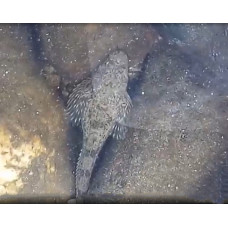Abyssocottinae is a family of fish of the order Scorpaeniformes. Endemics of Lake Baikal. Abysssocottus elochini lives at depths of 300 m, Abyssocottus gibbosus and Abyssocottus korotneffi - from 400 to 1600 m. The largest species of the family Procottus jeittelesii reaches 28 cm in length, and the smallest representative - Procottus gurwici, about 6 cm. These are mostly small fish, often with their heads flattened in the dorso-ventral direction; they live only in Baikal and at great depths. They differ from all fishes of the order Scorpaeniformes in the absence of sensory canals on the head; the seismosensory system is represented only by external neuromasts.
Fish of the genus Abyssocottus are characterized by a completely naked body, the lateral line in the front of the body consists of several rows, the middle row of 30-60 neuromasts, which go over the median ray of the caudal fin. The head is flattened, large. The eyes are small, located in deep eye sockets. Suborbital bones of the skull are prominent. There are 31-33 vertebrae.
Abyssocottus elochini has short body, large and strongly flattened head, its width is greater than height at occiput. Coloration of head and upper part of body is monochromatic, dark-brown. The lower part of the body is light-colored. The snout is broad, shovel-shaped, with a tubercle at the front edge. The jaws almost reach the vertical of the middle of the eye. The forehead is wide, larger than the longitudinal diameter of the eye. Front nostrils are in the form of long, narrow, pigmented, leathery tubes, slightly tapered upward. Posterior nostrils have the form of short, wide pigmented tubes. The gill slit is small, and the intergill space is very narrow.
The seismosensory system is represented by external neuromasts, which are located on thin, delicate, hair-like papillae, up to 1 mm high, partially pigmented at the base. The lateral line consists of 33 neuromasts, of which 2 are located on the median ray of the caudal fin. Above the lateral line there are 2 additional rows of neuromasts: the upper one, long, of 18 and below it short, of 5 neuromasts. Below the lateral line there is another additional row of 8 neuromasts.
The rays of all fins are pigmented, but not equally so. On the rays of the dorsal, pectoral, and caudal fins, the pigment is formed in dark bands, and on the anal and pelvic fin rays only as individual melanophores. The interradial septa are thin, unpigmented. The pectoral fins are short, ending on the vertical of the first ray D2. The pelvic fins do not reach the anal opening, but are relatively long, almost the same length as the pectoral fins. The dorsal fins are connected by a skin fold. The second dorsal fin is higher than the anal fin, but of equal length to it.
Gill stamens 4, they are small tubercle-shaped, completely covered with spines, rarely sit on the gill arch. Pyloric appendages are 3, very short and thick. There are 32 vertebrae (10 trunk vertebrae and 22 caudal vertebrae). There are no subspecies.
The family Abyssocottinae includes 24 species, 7 genera. Sometimes they all are included in the family Cottidae and genus Cottus. In some systems, the genus Cyphocottus Gratzianov, 1902 is synonymized with the genus Limnocottus, and some species of the genus Procottus are included in the genus Metacottus Taliev, 1946. Earlier it was united with family Cottocomephoridae. Non-target and rare species.
Abyssocottinae
Tags: abyssocottinae


